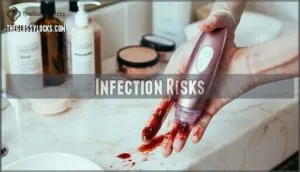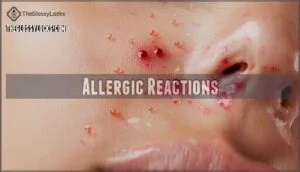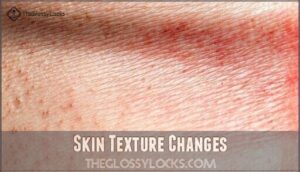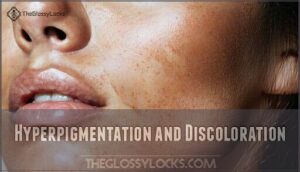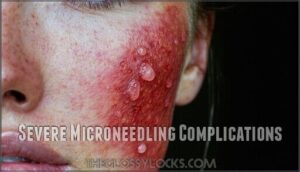This site is supported by our readers. We may earn a commission, at no cost to you, if you purchase through links.

Expect redness like a mild sunburn, some swelling, and tiny pinprick bleeding that’ll fade within 24-48 hours.
Your skin might feel tight, dry, or sensitive to touch for a few days. Think of it as your skin’s way of saying, "Thanks for the wake-up call!"
Most people see peeling and flaking around day three – that’s just old skin making room for the good stuff underneath.
Sun sensitivity peaks during healing, so sunscreen becomes your best friend. While these reactions might make you question your life choices temporarily, they’re actually signs your treatment is working.
Understanding what’s normal versus concerning can save you from unnecessary panic calls to your provider.
Table Of Contents
- Key Takeaways
- Microneedling Side Effects
- Common Microneedling Risks
- Managing Side Effects
- Minimizing Side Effect Risks
- Severe Microneedling Complications
- Frequently Asked Questions (FAQs)
- What is microneedling?
- What are the pros and cons of microneedling?
- How much does microneedling cost?
- Who makes a good candidate?
- What does microneedling do for your skin?
- What happens during a microneedling treatment?
- How often should you do microneedling?
- How long does microneedling take to heal?
- What’s the best protocol for microneedling aftercare?
- What are the risks of microneedling?
- Conclusion
Key Takeaways
- You’ll experience normal redness, swelling, and minor bleeding that typically resolve within 24-48 hours – these aren’t reasons to panic but signs your treatment’s working.
- Your skin will become extra sensitive to sun exposure for 3-7 days, so you’ll need to apply SPF 30+ every two hours and avoid direct sunlight to prevent permanent discoloration.
- Expect dryness and peeling around day three as old skin sheds – this is part of the renewal process, so don’t use harsh scrubs and stick to gentle, fragrance-free moisturizers.
- Watch for warning signs like persistent pain, pus formation, or worsening symptoms beyond a week – these indicate complications that need immediate medical attention.
Microneedling Side Effects
You’ll likely experience some temporary side effects after microneedling, but most are mild and resolve within a few days.
Understanding what’s normal helps you distinguish between expected reactions and signs that warrant professional attention.
Redness and Irritation
Why does your face look like a tomato after microneedling?
Facial redness and skin irritation are the most common side effects you’ll experience. The causes of redness stem from controlled trauma to your skin, triggering inflammation.
Duration of irritation typically lasts 2-4 hours for most people, though sensitive skin may stay red longer.
Managing discomfort involves gentle post-procedure care and avoiding harsh products that worsen skin sensitivity, which can help mitigate the effects of skin irritation.
Swelling and Inflammation
Beyond the initial facial redness, you’ll likely notice post-procedure swelling within hours of treatment.
This inflammation duration typically lasts 24-48 hours as your skin responds to the controlled micro-trauma.
Managing discomfort becomes easier when you understand that swelling causes stem from your body’s natural healing process.
Reducing inflammation requires patience—think of it as your skin’s way of saying "I’m working on improvements."
Cool compresses help tame facial swelling effectively, and this can be seen as a way to support your skin’s natural inflammation response.
Minor Bleeding and Bruising
Most people experience minor bleeding and temporary bruising after microneedling—it’s completely normal.
Pin point bleeding occurs when needles create microscopic channels, while bruising develops from pressure effects on delicate vessels.
Bleeding causes typically resolve within hours, though bruising severity varies by individual, and vessel damage remains minimal with proper technique.
Your healing timeline usually spans 2-7 days for complete recovery, which is a relatively short period for such a procedure, and complete recovery is often achieved within this timeframe.
Dryness and Flaking
Your skin’s moisture barrier takes a hit after microneedling, leading to dryness and flaking as part of the natural healing process.
These temporary side effects occur because the tiny punctures disrupt your skin’s protective layer. Managing flaking skin requires gentle hydration—think fragrance-free moisturizers and hyaluronic acid serums.
Skip harsh exfoliation methods; let your skin shed naturally. Proper skincare aftercare with recommended products helps restore skin hydration and reduces sensitivity management concerns.
Consider using creams with ceramides for barrier repair to help replenish lost lipids.
Temporary Sensitivity to Sun
After experiencing dryness and flaking, you’ll notice your treated skin becomes particularly vulnerable to UV damage.
This heightened sun sensitivity occurs because microneedling creates temporary microscopic channels, compromising your skin’s natural protective barrier.
Your post-treatment care should prioritize sun protection to prevent complications:
- Apply broad-spectrum sunscreen with SPF 30+ every two hours, even indoors
- Avoid direct sun exposure for at least 48-72 hours after treatment
- Skip tanning beds completely during the healing process to prevent pigmentation risks
- Wear protective clothing and wide-brimmed hats when outdoors
This UV vulnerability typically lasts 3-7 days as your skin barrier repairs itself.
Ignoring sunscreen importance during this period can lead to unwanted skin redness, increased skin irritation, and even permanent discoloration.
Common Microneedling Risks
While microneedling is generally safe when performed properly, you should be aware of some common risks that can occur beyond the typical side effects.
These risks include potential infections from unsterile equipment, allergic reactions to topical products used during treatment, changes in skin texture, and unwanted pigmentation issues that may develop afterward, including infections from contaminated sources.
Infection Risks
While skin irritation is common, infections pose more serious risks you shouldn’t ignore.
Bacterial infections, viral transmission, and fungal infections can occur when infection control fails.
Improper sterilization increases your risk dramatically—78% of complications stem from poor hygiene practices.
Post-procedure care matters too; touching treated skin with dirty hands invites trouble.
Professional treatments substantially reduce infection risks compared to at-home devices.
The risk of infection is high with at-home microneedling.
Allergic Reactions
Rarely do microneedling patients experience allergic reactions, but when they occur, they’re usually triggered by serum allergens rather than the needles themselves.
Your skin’s increased permeability post-treatment can amplify hypersensitivity reactions to products that normally wouldn’t bother you.
Here are five key points about microneedling allergic reactions:
- Patch Testing Prevention – Test serums on a small skin area 24-48 hours before treatment to identify potential allergens
- Common Reaction Triggers – Vitamin C serums, numbing agents, and topical medications cause most post-treatment allergy issues
- Symptom Recognition – Watch for persistent itching, unusual swelling, or dermatitis-like reactions beyond normal healing
- Nickel Sensitivity Risk – Some devices contain metals that can trigger nickel-contact dermatitis in sensitive individuals
- Reaction Severity Varies – Symptoms range from mild skin irritation to severe hypersensitivity reactions requiring medical attention
Identifying allergens early helps prevent complications and guarantees safer future treatments.
Those with sensitive skin require extra care during procedures to avoid irritation.
Skin Texture Changes
Microneedling can temporarily make your skin feel like sandpaper—don’t panic! This rough texture typically lasts several days as your skin renews itself.
While collagen stimulation and elasticity improvement are happening beneath the surface, you might notice dryness, flaking, or slight swelling that affects skin smoothness.
These changes support pore size reduction and scar reduction over time, enhancing overall skin texture improvement through natural healing processes.
Hyperpigmentation and Discoloration
Up to 20% of patients develop post-inflammatory hyperpigmentation after microneedling, especially those with skin of color.
Dark spots and pigmentary demarcation lines can appear when excessive trauma triggers melanin overproduction.
Sun sensitivity increases melasma risk substantially. Proper discoloration prevention includes using SPF 50+ sunscreen and avoiding aggressive treatments on darker skin tones.
Managing Side Effects
When side effects do occur after microneedling, you’ll want to address them quickly to speed healing and prevent complications.
The good news is that most post-treatment symptoms respond well to simple home care measures when you know what to do.
Proper Cleansing and Moisturizing
After you’ve weathered the initial storm, your skin deserves the gentlest post-treatment care. Think of your freshly needled skin like delicate silk that needs careful handling.
Here’s your essential cleansing and moisturizing routine:
- Use gentle cleansers – Choose fragrance-free, pH-balanced formulas that won’t strip your compromised skin barrier or cause stinging
- Apply hydrating serums with hyaluronic acid or ceramides before your moisturizer to lock in moisture without irritating ingredients
- Follow with occlusive moisturizers containing petrolatum or dimethicone to seal in hydration and protect your healing skin
After microneedling, consider using products for sensitive skin to avoid irritation. Skip harsh topical products and stick to this simple skin care routine for ideal recovery.
Applying Cold Compresses
After microneedling, you’ll want to reduce inflammation and minimize swelling quickly. Cold compresses are your best friend for managing post-treatment discomfort.
Here’s how to numb discomfort effectively while promoting healing:
| Application Method | Duration | Frequency |
|---|---|---|
| Ice pack (wrapped) | 10-15 minutes | Every 2-3 hours |
| Cold compress | 5-10 minutes | As needed |
| Frozen peas/gel pack | 10 minutes max | 3-4 times daily |
| Cool wet cloth | 15-20 minutes | Hourly if needed |
Proper application means never placing ice directly on your skin—always wrap it in a thin towel.
This prevents frostbite while still delivering the cooling relief you need. You can find a variety of cold compress options designed for therapeutic use.
The compress duration matters; longer isn’t better and can actually slow healing. Focus on gentle pressure to target swelling, redness, and bruising without overdoing your post treatment care routine.
Using Gentle Products
Your skin needs TLC after microneedling, so reach for mild cleansers and hydrating serums that won’t sting or irritate.
Skip harsh scrubs, retinoids, and acids – your freshly treated skin can’t handle these irritants right now.
Soothing masks with gentle product ingredients help calm inflammation. Consider using these cleansers after microneedling for ideal results.
Think of your post treatment care routine like nursing a sunburn – baby your skin with topical products designed for sensitive skin until it heals completely.
Avoiding Makeup and Sun Exposure
Why would you sabotage your fresh microneedling results? Skip makeup and shield your skin from sun damage during the critical healing timeline.
Your newly treated skin needs gentle postprocedure care, not cosmetic stress.
- Ditch makeup ingredients that can clog healing micropunctures and trigger irritation
- Choose mineral sunscreen types with zinc oxide for gentle skin protection coverage
- Wear protective clothing like wide-brimmed hats for thorough sunprotective measures
- Practice smart skin sensitivity management by avoiding makeup application for 24-48 hours
Minimizing Side Effect Risks
While most people experience mild redness and swelling after microneedling, taking the right precautions can substantially reduce your risk of complications.
The key lies in proper preparation, choosing an experienced professional, and following post-treatment care instructions carefully.
Proper Pre-Treatment Skin Preparation
Several steps set you up for success when you’re getting ready for your microneedling appointment. Taking care of these prep tasks can make all the difference in how your skin responds.
Discontinue Topicals like retinol at least 48 hours before treatment, and Avoid Sun exposure for three days prior. Your skincare routine needs adjusting – stop aggressive acids within a week. Medication Review with your provider prevents complications, especially if you’re taking blood thinners.
| Preparation Step | Timeline |
|---|---|
| Stop retinol products | 48 hours before |
| Discontinue acid treatments | 1 week before |
| Avoid direct sun exposure | 3 days before |
| Arrive with clean, dry skin | Day of treatment |
Clean Skin is essential – arrive makeup-free for ideal results. Focus on Hydration Levels by drinking plenty of water beforehand. Practice good skin cleansing and gentle skin toning while avoiding harsh skin sensitivity management products that could irritate.
These skin care tips help minimize side effects and maximize your treatment benefits.
Choosing a Qualified Professional
Choosing the right professional dramatically reduces microneedling risks and complications.
Board-certified dermatologists possess specialized training to assess your skin type and select appropriate needle depths, preventing scarring risks and skin infection.
During consultation, verify credentials and review testimonials from patients with similar concerns.
Evaluate clinic hygiene standards and sterilization protocols.
Experience matters—seasoned practitioners recognize contraindications and adjust treatments accordingly, minimizing potential adverse reactions.
Following Aftercare Instructions
Your doctor’s posttreatment care instructions aren’t just suggestions—they’re your roadmap to smooth skin healing.
Following proper aftercare protocols substantially reduces skin inflammation and manages skin sensitivity.
Apply gentle serums for hydration importance, use cooling masks for mask benefits, and maintain strict sun protection.
Avoid irritants like harsh acids or retinoids during skin recovery to prevent complications and optimize results.
Spacing Treatments Appropriately
Patience plays a vital role in microneedling success—rushing between sessions can amplify side effects and compromise skin healing.
Your skin needs adequate recovery time between treatments to rebuild collagen and minimize downtime risks. Aiding this process involves effective skin renewal.
Optimal Intervals for Safe Treatment:
- Wait 4-6 weeks between professional microneedling sessions
- Allow 2-3 weeks minimum for at-home device treatments
- Monitor individual needs—some skin types require longer recovery
- Consider long-term effects when planning treatment frequency schedules
Severe Microneedling Complications
While most microneedling side effects resolve quickly, serious complications can develop that require immediate medical attention.
You’ll need to recognize warning signs like persistent infection, severe scarring, or unusual skin reactions that don’t improve within the expected timeframe.
Persistent or Worsening Side Effects
When normal microneedling side effects linger beyond a week or worsen over time, you’re facing potential microneedling complications that need immediate attention.
Your healing timeline shouldn’t include worsening symptoms—that’s your skin crying for help.
Persistent redness, increased pain, or developing scarring potential signal your skin isn’t healing properly.
These warning signs could indicate infection symptoms, nerve damage, or pigment changes that may lead to permanent scarring or treatment failure.
Signs of Infection
When should you worry about infection after microneedling? Watch for these warning signs that indicate your skin’s healing process has gone awry:
- Pus formation – Yellow or green discharge signals skin bacteria have invaded
- Increased pain that worsens rather than improves over days
- Persistent redness lasting beyond normal recovery timeframe
- Elevated temperature with swollen lymph nodes indicating systemic response
These infections require immediate medical attention to prevent serious skin side effects.
Redness and inflammation can also occur due to damaged hair follicles.
Severe Pain or Discomfort
While microneedling typically involves minimal discomfort with topical anesthetic, severe pain signals potential complications.
Excessive skin discomfort beyond normal post-treatment sensitivity may indicate nerve damage from aggressive treatment depth or improper technique.
Pain levels shouldn’t worsen after the initial procedure day, and persistent, throbbing pain warrants immediate medical attention, as it could suggest infection or scarring risks that require professional pain management intervention.
Unusual Skin Changes or Reactions
Skin-color changes and unusual tissue responses can signal serious complications beyond typical healing.
Watch for these warning signs:
- Granuloma Formation – firm bumps that persist weeks after treatment
- Keloid Scarring – raised, thickened scars extending beyond original treatment area
- Milia Development – small white cysts appearing on treated skin
- Persistent Erythema – redness lasting over two weeks without improvement
- Photosensitivity Flare – extreme sun sensitivity causing severe skin reaction
Postinflammatory hyperpigmentation, hypopigmentation, and dermatitislike reactions require immediate professional evaluation.
Frequently Asked Questions (FAQs)
What is microneedling?
This cosmetic procedure uses tiny, sterile needles to create controlled micro-injuries in your skin.
You’ll trigger your body’s natural healing response, boosting collagen production and improving texture, scars, and fine lines effectively.
What are the pros and cons of microneedling?
Benefits boost collagen production, reduce wrinkles, improve scars, and enhance skin texture. Risks include redness, bleeding, infection, bruising, and potential nerve damage, especially with deeper treatments.
How much does microneedling cost?
You’ll typically pay between $200-$800 per session, with lighter treatments starting around $
Most insurance won’t cover it since it’s cosmetic, but many clinics offer payment plans to make treatments more affordable.
Who makes a good candidate?
You’re an ideal candidate if you have realistic expectations about gradual results and healthy skin without active infections, severe acne, keloid scarring, or recent radiation therapy treatments.
What does microneedling do for your skin?
Microneedling creates tiny punctures in your skin, triggering your body’s natural healing response.
This stimulates collagen and elastin production, which smooths fine lines, reduces scars, and improves overall texture for firmer skin.
What happens during a microneedling treatment?
Imagine this scenario: thousands of tiny needles creating microscopic "injuries" across your face!
During treatment, your provider applies numbing cream, then uses a sterile device with fine needles to puncture your skin’s surface, stimulating natural healing and collagen production.
How often should you do microneedling?
Professional treatments work best when spaced 4-6 weeks apart. You’ll need 3-6 sessions for desired results. Your skin needs time to heal and produce new collagen between sessions.
How long does microneedling take to heal?
Your skin typically heals from microneedling within 24-72 hours, with most redness disappearing in a couple hours. Sensitive skin might feel raw for several days, but there’s minimal downtime overall.
What’s the best protocol for microneedling aftercare?
After your treatment, skip sun exposure and harsh products for a week. Use gentle hydrating serums, cooling masks, and avoid makeup, sweating, retinol, and acids to promote proper healing.
What are the risks of microneedling?
Did you know up to 90% of people experience mild redness after microneedling?
You might also see swelling, bruising, or dryness.
Rarely, folks get infections or pigment changes, so always follow aftercare and consult your provider.
Conclusion
Think of your skin recovery like a home renovation project – messy at first, but worth the beautiful results.
Understanding microneedling side effects helps you navigate the healing process with confidence rather than panic.
While redness, swelling, and peeling might make you second-guess your decision, these reactions signal your skin’s natural renewal process at work.
By following proper aftercare and recognizing warning signs that need professional attention, you’ll maximize your results while minimizing complications from this transformative treatment.

